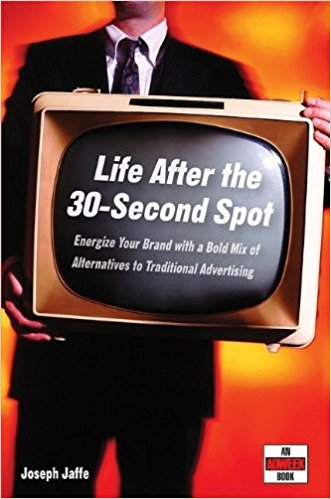Life After the 30-Second Spot Summary
5 min read ⌚

Energize Your Brand With a Bold Mix of Alternatives to Traditional Advertising
Are you into Marketing?
If you plan on taking your products to the next level, it’s best If you learn more about the recent trends that are taking over the digital age.
Who Should Read “Life After the 30-Second Spot”? And Why?
It’s ignorant to prepare a speech about who is best-equipped for a book that concern as all.
If at any point you plan on exploring the real power of your products/services, and calculate their impact, you are in the club of potential readers.
However, even if you tend to continue doing your business conventionally, you should at least scan “Life After the 30-Second Spot”.
About Joseph Jaffe
 Joseph Jaffe is the creator and president of a marketing and consulting company, named Jaffe, LLC. Despite his writing career, he is also the ex-Director of Interactive Media.
Joseph Jaffe is the creator and president of a marketing and consulting company, named Jaffe, LLC. Despite his writing career, he is also the ex-Director of Interactive Media.
“Life After the 30-Second Spot Summary”
At the expense of TV commercials, the digital world offers plenty of new ways that bring “death” to the old-school “screen ads.” This transformation poses a threat to some media because the shift is pushing them off a cliff.
Joseph Jaffe instigates people to adjust to the modern age, but he also promotes transparency. Neglecting the 30-second spots is equal to suicide for many businesses, so let’s move slowly.
First, this case is designed to conduct an unbiased investigation about the non-targeting 30-second ads. The Internet is a significant contributor to the inevitable collapse of newspapers and billboards age.
Since the beginning of the 90s, companies eager for success went full steam ahead to avoid financial disaster due to lack of flexibility and technological advancement.
Secondly, despite Jaffe’s openness and transparency, he refuses to share all the facts, and theories. The reason for doing so is left unknown to us.
Many top-notch brands like Coca-Cola, are not supporting the claims that the mass-marketing is no longer needed. The bottom line is, despite the modifications, it’s still available for brands to utilize its pull effect through various channels.
In the 50s, the Americans started the promoting a concept by which companies would become customer-centric. Nowadays, brands which refuse to follow and obey the demands, are prone to failure. In general, a large portion of marketing experts and agencies are still not too comfortable with the revolution that occurred on their turf.
The unavoidable truth didn’t manage to waver the TV agencies to continue doing business as they once were. In fact, these entities returned to placing media buys on cable television, without even the slightest hesitation.
A recently conducted study shows: People are trading the cable TV and broadcast for surfing or use of the Internet.
Don’t be surprised to know that many advertising agencies are still fiercely opposing the need for change. According to them, the actual power still lies within the commercial, and not in consumer’s demands as an empowered individual.
Top 10 recent changes:
- Smart consumers – Nowadays, the abundance of choices allows the customers to be peaky, and carefree. Regardless of the agencies’ claims, consumers are outmuscling the marketers in the 21st century.
- Consumers share their experience – Many renowned marketers are emphasizing the value of word-of-mouth. Take for example Starbucks. You can trick your potential buyers to purchase your commodities, but if you earn a bad reputation, your budget will not help you recover.
- Consumers question everything – Do you want a straight answer? Customers are not as dumb as a box of rocks. They can easily spot a fraud, well – most of them. That’s a clear sign that one mistake can take your company “downhill.”
- Consumers have unlimited access – Behind this operation, rises the all-powerful Internet, a product of the digital age.
- Consumers value their time and energy – The battle for attention is turning out be an endless war. Marketers and companies are giving everything in order to persuade the potential customers to join their cause.
- Consumers feel entitled to ask for an explanation – A outgrowth of the Internet is that customers are expecting quick responses to their complaints and demands.
- Consumer relationships are no longer stable – Brand loyalty is gradually vanishing because the relationships are built on flexibility. If you give them one reason to doubt your product, they’ll look for another vendor.
- The consumer is always ready to purchase – Did you know, if you cannot cope with the questions of your customer through a call center or another channel of communication, your consumers will search for a better solution.
- Consumers have no shortages of information – If you don’t give them the data they are looking for, they’ll find it someplace else.
- Consumers are unforgiving – If you as a consumer has a problem with a vendor, he/she can go public and share its concerns with the world.
Key Lessons from “Life After the 30-Second Spot”
1. The power of search
2. The engine of a public opinion
3. The modification hurts
The power of search
It’s evident that customers have no limitations when it comes to searching their preferable commodities. Not only search engines like Google, but also through other e-commerce websites, they can find absolutely anything.
The engine of a public opinion
If in the industrial your opinion was irrelevant, these days each company or seller displays a “leave a comment” option. The reason for doing so is simple: every person’s vote counts! How else would you improve your products without feedback?
The modification hurts
The new technologies and possibilities have led to the creation of unpredictable audience. Loyal groups are losing its grip, and all that is left of branding is improvements and working on customer satisfaction.
Like this summary? We’d Like to invite you to download our free 12 min app, for more amazing summaries and audiobooks.
“Life After the 30-Second Spot” Quotes
It all boils down to a finite amount of time and every moment of that precious time that a consumer elects to spend with you should be maximized, not reduced to beans, counted and valued accordingly. Click To Tweet When the dust settles, we are still dealing with only one consumer and one attention span. Click To Tweet A person’s content behavior in an on-demand world will often reveal his or her interests and passions, which will allow marketers to gain better insights and find new, engaging venues. Click To Tweet Nothing will ever replace smart thinking and the ability to pair the right brands with the right forms of entertainment or opportunities. Click To Tweet The 30-second spot - at least as it exists today - is either dead, dying or has outlived its usefulness. Click To TweetOur Critical Review
Life After the 30-Second Spot is an insightful and all-encompassing book as far as marketing is concerned. It covers a wide range of topics linked to promotion, branding, and commerce; all you’ll ever need before launching a campaign.
Emir is the Head of Marketing at 12min. In his spare time, he loves to meditate and play soccer.







